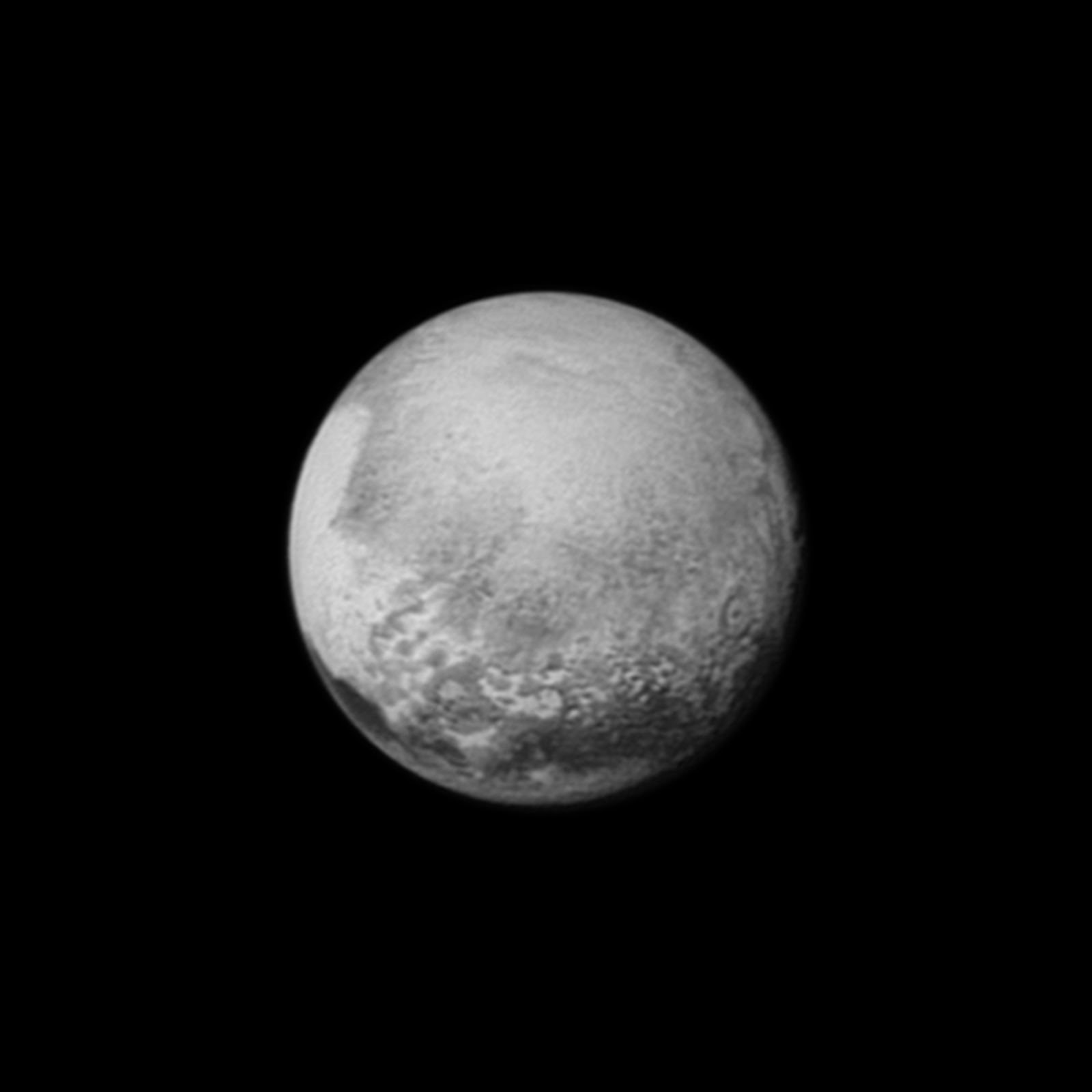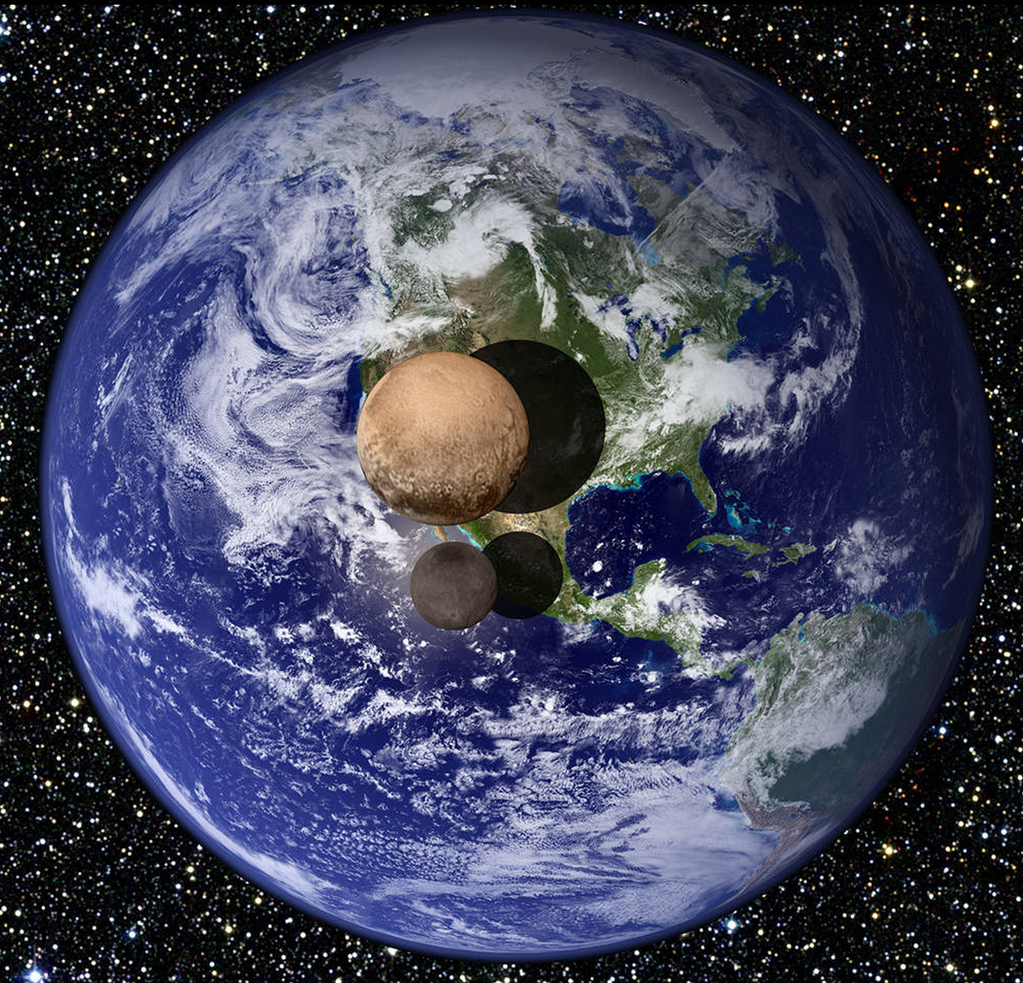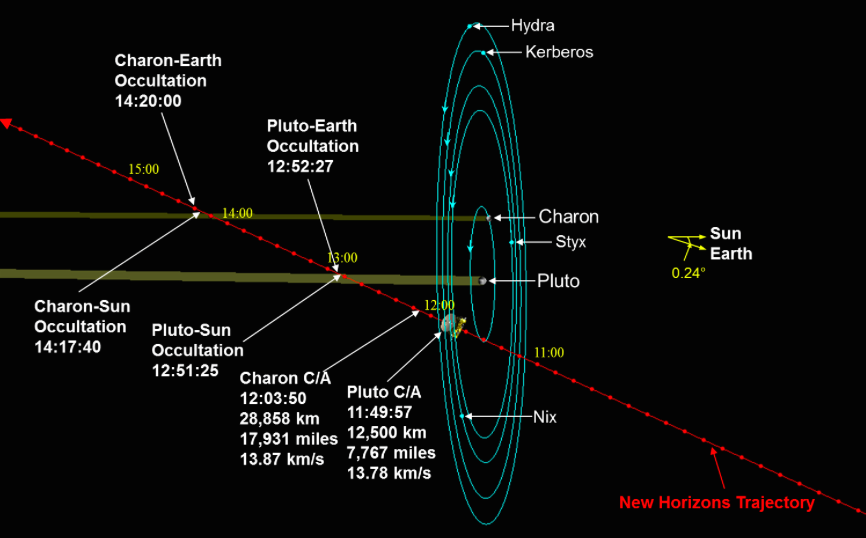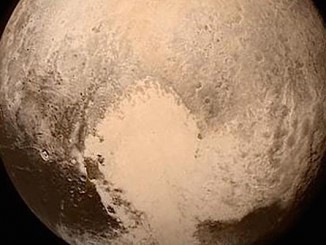
Using high-fidelity modeling and image analysis to resolve Pluto’s exact shape, scientists examining pictures from NASA’s New Horizons spacecraft said Monday they have confirmed Pluto is the largest known object in a frozen outer zone of the solar system called the Kuiper Belt.
“We’ve discovered that Pluto’s a little bit larger than we anticipated,” said Alan Stern, New Horizons’ principal investigator from the Southwest Research Institute. “We now have good measurements of its diameter. Its radius is 1,185 kilometers (736 miles), plus or minus 10 (6 miles). That settles the debate about the largest object in the Kuiper Belt.”
New Horizons is on track to speed past Pluto at an altitude of 7,750 miles (12,500 kilometers) a few seconds before 7:50 a.m. EDT (1150 GMT). About 14 minutes later, the probe will be closest to Pluto’s largest moon Charon at a range of about 18,000 miles, or 29,000 kilometers.
Only about 1 percent of the spacecraft’s total data haul is coming back to Earth during the flyby. The rest of the observations are stored on New Horizons’ two 64-gigabit data recorders for downlink to Earth over a time lag during the next 16 months due to the vast three billion-mile distance to Pluto.
But a taste of data is coming down from Pluto before the encounter. The so-called “fail safe” observations give scientists a glimpse of what’s to come from New Horizons, and it is insurance in case something goes wrong Tuesday.
Officials expect no problems, however, and New Horizons is programmed with autonomous software to control more than 150 individual science observations Monday and Tuesday, firing its thrusters to spin around and aim instruments at Pluto, Charon, and the icy dwarf’s other tiny satellites.
“Pluto is kind of a capstone of our solar system exploration,” said John Grunsfeld, head of NASA’s science directorate. “Pluto’s a member of our solar system and the last unexplored territory. We’re opening up new ground.”

The refined estimate of Pluto’s size confirms it is slightly larger than Eris, a dwarf planet whose discovery in 2005 ignited a debate over how to classify large Kuiper Belt objects, eventually resulting in a controversial decision by the International Astronomical Union to put Pluto, Eris and other similar objects in the new category of dwarf planets.
Pluto’s diameter is roughly 1,472 miles (2,370 kilometers), about the distance from San Francisco to Dallas. Eris is approximately 1,445 miles, or 2,326 kilometers, across.
Eris is still more massive than Pluto, and Stern — a vocal defender of Pluto’s status in the solar system — said the fresh number on Pluto’s size means scientists must rethink how the innards of the icy world are structured.
Stern’s science team may have to account for more ice inside Pluto than predicted.
“The fact that the planet is larger than expected lowers the net density,” Stern said in a media briefing Monday. “That raises the net ice content that’s inside, lowering the rock content. That has implications for things like how the binary (Pluto and Charon) formed. It has implications for the chemistry of the solar nebula, implications for the atmosphere, having a shallower troposphere. It’s still something we need to unravel in the future. This is news that’s less than a day old, when we really got the consensus that the technique had the right error bars and had the right number.”
The so-called Kuiper Belt is a ring of frozen primordial remnants from the formation of the solar system about 4.6 billion years ago.
Stern told reporters Sunday that New Horizons’ visit to Pluto, although brief, will fill key gaps in how scientists think of the early solar system, when planets started forming as collisions between proto-worlds dozens to hundreds of miles across generated larger and larger objects that became the planets.
The process is called accretion.
“We hope to connect the dots a lot better in the accretion process,” Stern said. “That’s big picture, how planets form.”
Scientists could not pinpoint Pluto’s size from Earth due to interference from the distant world’s thin atmosphere. Astronomers estimated Pluto’s radius by watching the icy dwarf pass in front of stars, using the time that Pluto blocked light from the star to come up with a rough guess on the frozen planet’s size.
“Pluto’s size has been uncertain in the past primarily because it has an atmosphere,” Stern said. “And the atmosphere is dense enough that it can actually create mirages when stars are observed through occultations and set behind the planet.”
Stern said New Horizons’ imaging team analyzed photos of Pluto to come up with its size, then confirmed the estimate by comparing it to the moon Charon, which has a known radius because it has no significant atmosphere to interfere with long-range size measurements from Earth.
Before New Horizons arrived at Pluto’s doorstep, scientists thought the radius of the mysterious world could measure between 1,150 and 1,200 kilometers (715-745 miles).

“What we found is Pluto is almost at the top of that range, but you need to anchor the technique in order to be certain in our numbers,” Stern said. “There’s some ground truth in the system. The moon Charon has no atmosphere so it doesn’t create those mirages.”
Stern teased a few other science results after a first brush of data coming down from New Horizons.
“The science that we’ve already made is mouth-watering,” Stern said. “The Pluto system is enchanting in its strangeness, in its alien beauty. It’s showing us tremendous diversity between the two planets in the system and their moons. We are already seeing complex and nuanced surfaces that tell us a history of these two bodies that is probably beyond our wildest dreams on the science teams. Pluto has not disappointed.”
A bright deposit near Pluto’s north pole, first observed months ago and hypothesized to be a polar ice cap, is now confirmed to be a patch of frozen nitrogen and methane by New Horizons’ Alice ultraviolet spectrometer.
“So we’ve now fingerprinted, it is an icy polar cap after all,” Stern said.
And particles from Pluto’s nitrogen-rich atmosphere, one hundred thousandth as thick as Earth’s, seems to be streaming away at a faster rate than expected. Many scientists believe Pluto’s atmosphere will freeze out and disappear as it swings farther from the sun in its 248-year orbit.
“We have discovered that we are already detecting nitrogen escaping from Pluto’s atmosphere,” Stern said. “And the important part of that is it was discovered five days ago, much farther from Pluto than we anticipated. This may mean that Pluto’s escape rate is higher than models had shown, or it may mean the transport mechanism is different from what we anticipated.”
But the best is yet to come.

“As we’re getting closer to the Pluto system, Pluto and Charon are getting larger in the fields-of-view of the instruments,” said Cathy Olkin, deputy project scientist from the Southwest Research Institute.
New Horizons’ telescopic camera will resolve objects as small as 230 feet, or 70 meters, at closest approach.
“Right here, we’re taking data that if you could transport (New York’s) Central Park to Pluto, you could be able to identify the ponds in Central Park,” Olkin said. “That’s the kind of resolution we’ll be getting in the strip of observations with the high-resolution camera as we fly through closest approach.”
On the way outbound after Tuesday’s encounter, New Horizons will peer back toward Pluto and Charon and listen for blasts of radio waves sent up from antennas on Earth. An experiment aboard New Horizons is tuned to measure how air distorts the signals, yielding findings on the profile of Pluto’s atmosphere and whether Charon also harbors a thin veneer of gas over its cratered surface.
“As we get farther away from the system, we’re going to look back and take images of the lit cresents of Pluto and its moons, and we’ll be searching for clouds and hazes in Pluto’s atmosphere using these observations,” Olkin said.
All of the observations will happen under the guidance of New Horizons’ on-board computer, which is loaded with software logic to control hundreds of maneuvers to ensure each instrument gets the data scientists need through Thursday, when another command sequence takes over.
It takes more than nine hours for signals to travel to and from Pluto, leaving ground controllers out of the loop. The spacecraft has two redundant computers, and each observation is programmed into the flyby sequence twice to help ensure no technical snag disrupts the plan.
Because its high-gain X-band antenna is fixed — a design decision made in the early 2000s to reduce cost — New Horizons can’t call home when it is pointing its apertures toward Pluto and its moons.
The team will mark the 7:50 a.m. EDT (1150 GMT) flyby Tuesday with celebration, but officials will not be able to verify New Horizons successfully made the flyby until a communications signal hits Earth around 8:53 p.m. (0053 GMT Wednesday), when the probe takes a brief break to radio home.
“New Horizons will be out of touch around those hours around closest approach, and while I don’t lose sleep over this, the fact is tomorrow evening is going to be a little bit of drama,” Stern said.
Email the author.
Follow Stephen Clark on Twitter: @StephenClark1.



